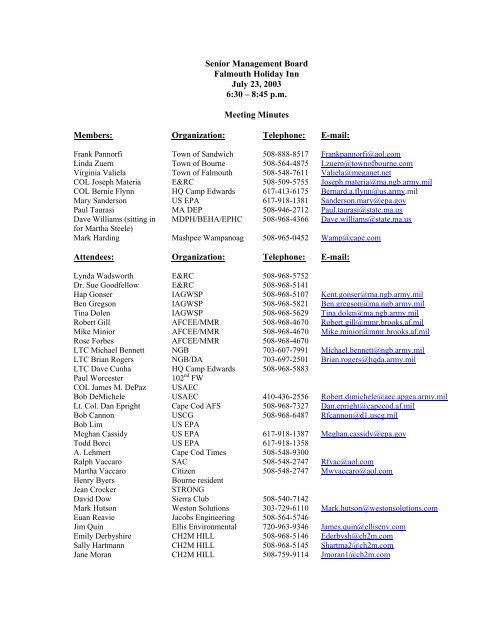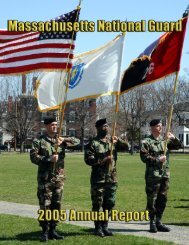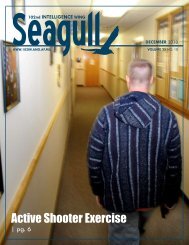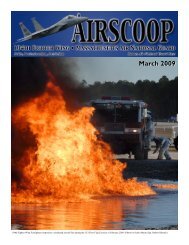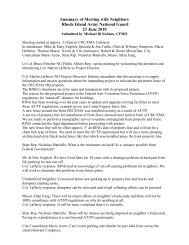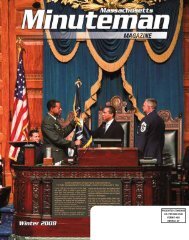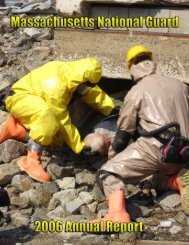Senior Management Board, July 23, 2003 - STATES - The National ...
Senior Management Board, July 23, 2003 - STATES - The National ...
Senior Management Board, July 23, 2003 - STATES - The National ...
You also want an ePaper? Increase the reach of your titles
YUMPU automatically turns print PDFs into web optimized ePapers that Google loves.
<strong>Senior</strong> <strong>Management</strong> <strong>Board</strong><br />
Falmouth Holiday Inn<br />
<strong>July</strong> <strong>23</strong>, <strong>2003</strong><br />
6:30 – 8:45 p.m.<br />
Meeting Minutes<br />
Members: Organization: Telephone: E-mail:<br />
Frank Pannorfi Town of Sandwich 508-888-8517 Frankpannorfi@aol.com<br />
Linda Zuern Town of Bourne 508-564-4875 Lzuern@townofbourne.com<br />
Virginia Valiela Town of Falmouth 508-548-7611 Valiela@meganet.net<br />
COL Joseph Materia E&RC 508-509-5755 Joseph.materia@ma.ngb.army.mil<br />
COL Bernie Flynn HQ Camp Edwards 617-413-6175 Bernard.a.flynn@us.army.mil<br />
Mary Sanderson US EPA 617-918-1381 Sanderson.mary@epa.gov<br />
Paul Taurasi MA DEP 508-946-2712 Paul.taurasi@state.ma.us<br />
Dave Williams (sitting in<br />
for Martha Steele)<br />
MDPH/BEHA/EPHC 508-968-4366 Dave.williams@state.ma.us<br />
Mark Harding Mashpee Wampanoag 508-965-0452 Wamp@cape.com<br />
Attendees: Organization: Telephone: E-mail:<br />
Lynda Wadsworth E&RC 508-968-5752<br />
Dr. Sue Goodfellow E&RC 508-968-5141<br />
Hap Gonser IAGWSP 508-968-5107 Kent.gonser@ma.ngb.army.mil<br />
Ben Gregson IAGWSP 508-968-5821 Ben.gregson@ma.ngb.army.mil<br />
Tina Dolen IAGWSP 508-968-5629 Tina.dolen@ma.ngb.army.mil<br />
Robert Gill AFCEE/MMR 508-968-4670 Robert.gill@mmr.brooks.af.mil<br />
Mike Minior AFCEE/MMR 508-968-4670 Mike.minior@mmr.brooks.af.mil<br />
Rose Forbes AFCEE/MMR 508-968-4670<br />
LTC Michael Bennett NGB 703-607-7991 Michael.bennett@ngb.army.mil<br />
LTC Brian Rogers NGB/DA 703-697-2501 Brian.rogers@hqda.army.mil<br />
LTC Dave Cunha HQ Camp Edwards 508-968-5883<br />
Paul Worcester 102 nd FW<br />
COL James M. DePaz USAEC<br />
Bob DeMichele USAEC 410-436-2556 Robert.dimichele@aec.apgea.army.mil<br />
Lt. Col. Dan Epright Cape Cod AFS 508-968-7327 Dan.epright@capecod.af.mil<br />
Bob Cannon USCG 508-968-6487 Rfcannon@d1.uscg.mil<br />
Bob Lim US EPA<br />
Meghan Cassidy US EPA 617-918-1387 Meghan.cassidy@epa.gov<br />
Todd Borci US EPA 617-918-1358<br />
A. Lehmert Cape Cod Times 508-548-9300<br />
Ralph Vaccaro SAC 508-548-2747 Rfvac@aol.com<br />
Martha Vaccaro Citizen 508-548-2747 Mwvaccaro@aol.com<br />
Henry Byers Bourne resident<br />
Jean Crocker STRONG<br />
David Dow Sierra Club 508-540-7142<br />
Mark Hutson Weston Solutions 303-729-6110 Mark.hutson@westonsolutions.com<br />
Euan Reavie Jacobs Engineering 508-564-5746<br />
Jim Quin Ellis Environmental 720-963-9346 James.quin@ellisenv.com<br />
Emily Derbyshire CH2M HILL 508-968-5146 Ederbysh@ch2m.com<br />
Sally Hartmann CH2M HILL 508-968-5145 Shartma2@ch2m.com<br />
Jane Moran CH2M HILL 508-759-9114 Jmoran1@ch2m.com
Handouts Distributed at Meeting:<br />
1. Lease Extension Public Information – web site address<br />
2. Presentation slides: Draft Programmatic Agreement for Cultural Resources at MAARNG Facilities<br />
3. Invitation to comment on the Proposed Programmatic Agreement for Cultural Resources<br />
4. Presentation handout: US Army Environmental Center<br />
5. Presentation handout: Western Boundary<br />
6. Presentation handout: Central Impact Area Update<br />
7. Presentation handout: Landfill 1 2002 Annual Report (August 2001 – <strong>July</strong> 2002)<br />
8. Map: IRP Plumes and Treatment Systems – January <strong>2003</strong><br />
9. E&RC information piece<br />
Agenda Item #1. Introductions, Approval of March 26, <strong>2003</strong> Meeting Minutes and<br />
Agenda Review<br />
Ms. Valiela convened the meeting at 6:35 p.m. and the <strong>Senior</strong> <strong>Management</strong> <strong>Board</strong> (SMB) members<br />
introduced themselves. Ms. Valiela asked if there were any changes or additions to the May 28, <strong>2003</strong><br />
SMB meeting minutes. No changes were offered and the minutes were approved as written.<br />
Agenda Item #2. Late-Breaking News<br />
No late-breaking news was reported at this time.<br />
Agenda Item #3. SMB/Community News<br />
Public Information on Lease Extension<br />
COL Materia stated that the June 30, <strong>2003</strong> public meeting regarding the base lease extensions was well<br />
attended by members of the public who were able to ask questions of Secretary Flynn from the<br />
Executive Office of Public Safety and Secretary Foy from the Governor’s staff. He also noted that<br />
documents regarding the lease are posted on the Environmental & Readiness Center (E&RC) web site.<br />
Those documents include the proposed lease summaries, a copy of the memorandum of agreement,<br />
and letters from Mr. Fatz of the Department of the Army and Ms. Coates of the Department of the Air<br />
Force regarding commitment on Massachusetts Military Reservation (MMR) investigation and<br />
cleanup efforts. COL Materia also said that a 30-day public comment period on the proposed leases<br />
began on <strong>July</strong> 15, <strong>2003</strong> and will run through August 15, <strong>2003</strong>. Ms. Valiela added that the e-mail<br />
address for submitting comments is dshaw@massmail.state.ma.us.<br />
Water Supply<br />
Mr. Gill said that the reason he is giving the water supply briefing is because after the Joint Program<br />
Office (JPO), which had served as the “water czar for the military at MMR,” was closed down, he, Mr.<br />
Gonser, and COL Materia decided that the “water czar” role would be taken up by him, as the<br />
Installation Restoration Program (IRP) chief. He also noted that at the round of meetings with the<br />
local water suppliers two months ago, they were informed that he would be their first point of contact<br />
to discuss any issues they want to raise about water supply.<br />
SENIOR MANAGEMENT BOARD MEETING – JULY <strong>23</strong>, <strong>2003</strong> PAGE 2 OF 15
Mr. Gill then stated that following the meetings with the water suppliers, the E&RC sent out letters to<br />
each of the four towns, basically summarizing those meetings and inviting the water suppliers to<br />
address any specific concerns to him or Mr. Gonser. He also noted that he sent out letters to each of<br />
the water superintendents stating that the Air Force Center for Environmental Excellence (AFCEE)<br />
would stand ready to enter into agreements to compensate for additional water supply costs that could<br />
be attributed to contamination from the base.<br />
Mr. Gill reported that he received a letter from Falmouth’s water superintendent, outlining some<br />
requirements he’d like AFCEE to consider, and a meeting to discuss those issues is scheduled for this<br />
Friday, <strong>July</strong> 25, <strong>2003</strong>. Also, he received a letter from the Bourne Water District water superintendent.<br />
However, most of the issues discussed in that letter pertained to groundwater contamination being<br />
addressed under the Impact Area Groundwater Study Program (IAGWSP), and the plan is to continue<br />
discussing those issues at meetings regularly held between the Bourne Water District and the<br />
IAGWSP. Mr. Gill also noted that AFCEE is in the process of closing out an agreement with the<br />
Sandwich Water District to reimburse the town for the cost of a pipeline that was installed in the past.<br />
Questions and Comments from SMB and Public<br />
Ms. Valiela said that the remaining water issues in the four towns that surround the base have been<br />
linked to the lease extensions. She then asked what kind of closure there would be if a town doesn’t<br />
indicate that it has needs before the lease issue has been settled. Mr. Gill replied that AFCEE would<br />
still stand ready to address any requirements that would be raised at any time, regardless of whether<br />
the leases have been extended. He also noted that in past years about $52 million in Air Force and<br />
Army money has been provided to the towns for water system replacements or improvements, without<br />
the motivator of a lease extension. Mr. Gill said that in the future if any of the four towns come<br />
forward with other requirements, they would be reviewed and evaluated in the same way as past<br />
agreements.<br />
Draft MAARNG Programmatic Agreement for Cultural Resources<br />
Dr. Goodfellow stated that cultural resource issues at the MMR and statewide for the Massachusetts<br />
Army <strong>National</strong> Guard (MAARNG) are governed by two laws: on the state level, Massachusetts<br />
General Laws (MGL), and on the federal level, the <strong>National</strong> Historic Preservation Act. <strong>The</strong><br />
programmatic agreement addresses the regulations under the <strong>National</strong> Historic Preservation Act and<br />
MGL specifically.<br />
Dr. Goodfellow explained that under current compliance practice, each project is reviewed on a caseby-case<br />
basis with respect to cultural resource issues. For each project, a project notification form is<br />
submitted to the State Historic Preservation Office (SHPO) and to the Wampanoag tribe for review<br />
and what is typically a 30-day comment period. <strong>The</strong> parties can concur with the determinations made<br />
regarding the effects of the project, or they can decide not to concur, in which case the project would<br />
be reevaluated and another review would be required. Dr. Goodfellow stated that the review process<br />
for any average project, regardless of size, could take at least 35 to 40 days, and sometimes longer.<br />
Dr. Goodfellow then noted that a programmatic agreement (PA) is a legally binding agreement signed<br />
by a number of agencies. In this case, the signing agencies would be the MAARNG, the <strong>National</strong><br />
Guard Bureau (NGB), the Wampanoag Tribe of Gayhead - Aquinnah, the SHPO, and the Advisory<br />
Council on Historic Preservation (ACHP), which is the national body. <strong>The</strong> PA sets forth alternate<br />
procedures for the MAARNG to use to satisfy certain elements of compliance on certain categories of<br />
projects. <strong>The</strong> PA is not a replacement of all review for cultural resources, and it doesn’t satisfy<br />
SENIOR MANAGEMENT BOARD MEETING – JULY <strong>23</strong>, <strong>2003</strong> PAGE 3 OF 15
compliance under all of the federal laws that exist. Rather, it specifically deals with the <strong>National</strong><br />
Historic Preservation Act and the MGL, and only for certain categories of projects. Dr. Goodfellow<br />
also sated that the PA would be signed to govern compliance for MAARNG projects involving historic<br />
properties statewide, not just at MMR.<br />
Dr. Goodfellow explained that from the MAARNG’s perspective, the advantage of implementing a PA<br />
is that it would streamline compliance on certain time-sensitive projects. From the perspective of the<br />
SHPO and the Wampanoag Tribal Historic Preservation Office (THPO), implementing a PA would<br />
save them a lot of paperwork and a lot of time. Dr. Goodfellow noted that, as the Regional Cultural<br />
Resources Manager, she sends the SHPO and THPO an average of 60 or more project notification<br />
forms for review per year. With a PA in place, however, she would be allowed to do a good deal of<br />
review in-house, then summarize the compliance review on an annual basis in an annual report and<br />
meeting.<br />
Dr. Goodfellow stated that the PA would allow her to conduct streamlined, in-house reviews for the<br />
following categories of projects: construction of investigative monitoring wells and soil sampling;<br />
ground disturbance related to soil remediation and/or unexploded ordnance (UXO) investigations;<br />
roadwork along established roads and trails; use of new borrow pits or expansion of existing borrow<br />
pits; construction and maintenance of unpaved parking areas less than five acres in size; new<br />
construction projects at MAARNG facilities involving ground disturbance of areas less than five acres;<br />
and repair or replacement of roofing, windows, doors, electrical, and other systems in historic<br />
buildings, as long as that replacement is done with “in kind” materials. <strong>The</strong> PA also provides for<br />
certain kinds of undertakings to be entirely exempt from external review. <strong>The</strong>se include: ground<br />
disturbance from training that occurs in previously disturbed areas; actions that take place in areas with<br />
confirmed or documented UXO; regular maintenance of established firebreaks and other easements;<br />
routine facility maintenance; and construction of investigative monitoring wells and/or soil sampling<br />
and UXO investigations in low-sensitivity or disturbed areas.<br />
Dr. Goodfellow explained that with the alternate procedures, if her in-house review of an undertaking<br />
on the list indicates a minimal potential to affect cultural resources, she would approve the project,<br />
keep an in-house record of the compliance review, and include it in a summary in an annual report that<br />
would be submitted to the SHPO, the Wampanoag, the Stockbridge-Munsee, which is the other<br />
federally-recognized tribe in Massachusetts, and other interested parties. If, however, she determined<br />
that there’s potential to impact resources, the undertaking would go beyond the purview of the PA and<br />
would undergo a regular case-by-case review as mandated under state and federal law. Dr.<br />
Goodfellow then mentioned that the annual report format provided in the actual agreement is posted on<br />
the E&RC web site.<br />
Dr. Goodfellow summarized by saying that the PA would let her to look at certain categories of<br />
projects—most importantly, the installation of monitoring wells—so it wouldn’t be necessary to wait<br />
for 30-day reviews by the SHPO and the THPO, thereby allowing the IAGWSP to move ahead more<br />
quickly with some of its investigations. She also noted that the entire PA is provided on the E&RC<br />
web site.<br />
Questions and Comments from SMB and Public<br />
Ms. Valiela asked for confirmation that if Dr. Goodfellow finds a potential impact to a cultural<br />
resource in her review of a project, it would undergo the normal review process. Dr. Goodfellow<br />
confirmed that this is so.<br />
SENIOR MANAGEMENT BOARD MEETING – JULY <strong>23</strong>, <strong>2003</strong> PAGE 4 OF 15
Ms. Sanderson asked how the PA would affect the IRP cleanup. Dr. Goodfellow explained that<br />
because the IRP is run by a different agency, it is responsible for its own environmental compliance<br />
actions. However, if the IRP does work on property licensed or owned by the MAARNG, she would<br />
have input into the compliance actions. She noted that in the past she reviewed the IRP’s Chemical<br />
Spill 19 (CS-19) well, which is located in the Impact Area in an area that’s already been documented<br />
as disturbed.<br />
Mr. Harding inquired about the end date of the comment period on the PA. Dr. Goodfellow replied<br />
that comments could be submitted until August 29, <strong>2003</strong>. She also noted that if no significant changes<br />
are made to the document after all the comments have been collected, it would be forwarded to the<br />
NGB, the U.S. Army Environmental Center (USAEC), and the ACHP for signature. If substantive<br />
comments were submitted, however, she would revise the document and put it out for another 30-day<br />
review.<br />
Mr. Dow noted that the lease extensions are defined by the existing leases, yet as of last Friday the<br />
existing leases were not available on the E&RC web site. COL Materia stated that both the Army’s<br />
and Air Force’s existing leases have since been posted on the web site.<br />
Agenda Item #4. Impact Area Groundwater Study Program Updates<br />
U.S. Army Environmental Center<br />
COL De Paz, commander of the USAEC, said that he would be providing an overview of the USAEC<br />
that focuses primarily on its cleanup and restoration work and how that ties in to Camp Edwards at<br />
MMR, rather than its work related to cultural and natural resources. He explained that the USAEC is a<br />
field operating agency under the Department of the Army, specifically the Assistant Chief of Staff for<br />
Installation <strong>Management</strong>. <strong>The</strong> intent of the USAEC, as an implementing tool for the Army, is to<br />
promote and provide innovative and cost-effective products and services that support the Army’s<br />
mission and capability to train and to operate, while preserving human health and the environment<br />
COL De Paz then noted that he came to the USAEC as its commander 11 months ago, after three years<br />
at the Pentagon working counter-proliferation of weapons of mass destruction. He also noted that he<br />
had technical experts with him in the audience available to answer any questions beyond his<br />
knowledge or experience.<br />
COL De Paz stated that the “Army environmental universe” encompasses more than 16 million acres;<br />
more than 4,000 installations, which include both <strong>National</strong> Guard armories and reserve facilities; more<br />
than 170 endangered species; more than 100,000 known cultural resources; 10,000 ranges; and 2,500<br />
environmental permits. He said that the USAEC is finding ways for the Army to continue to train<br />
effectively and be ready to fight the nation’s wars, despite the challenges associated with the desert<br />
tortoise at the national training center on the west coast and those associated with the red-cockaded<br />
woodpecker at Fort Bragg, North Carolina.<br />
COL De Paz said that in the area of base operations, the USAEC’s goal is to integrate pollution<br />
prevention and compliance to promote the well-being of the installations and the neighboring<br />
communities, and clean up from past practices to return lands to beneficial use. In the area of<br />
sustainable ranges, the goal is to ensure that the Army’s land base is sustainable for solider training,<br />
whether through rotating training areas in order to allow time for the land to recover, or by taking<br />
specific actions, such as replanting or burning, to help the recovery process. In the area of Army<br />
transformation, the USAEC has some involvement in the acquisition process for new weapons systems<br />
SENIOR MANAGEMENT BOARD MEETING – JULY <strong>23</strong>, <strong>2003</strong> PAGE 5 OF 15
and equipment, with the goal of enhancing the Army’s ability to transform and to design and field new<br />
equipment that is environmentally compliant and sustainable.<br />
COL De Paz further noted that in the area of communications and customers, the USAEC’s goal is to<br />
ensure effective communication and fully understand what is needed to maintain the nation’s fighting<br />
force. As a liaison and advocate, the USAEC has four small regional environmental offices: one in<br />
Atlanta, one in Kansas City, one in Denver, and one co-located with USAEC Headquarters at<br />
Aberdeen Proving Ground, Maryland. Personnel at these regional offices represent the Army’s<br />
interests in developing federal, regional, and state environmental legislation, regulations, and policy.<br />
<strong>The</strong>y work toward finding solutions that satisfy the goals of all parties, at the same time allowing the<br />
Army to train while meeting environmental concerns.<br />
COL De Paz also said that sound business practices are a goal of the USAEC, i.e., making the most of<br />
available resources and dollars, as is workforce excellence, i.e., maintaining a motivated, proactive,<br />
and professional interdisciplinary team to support all of USAEC’s goals and missions across the Army.<br />
He noted that recently there were more than 100 applicants per open position at some of USAEC’s<br />
regional offices, and the USAEC is very selective in hiring individuals who provide the expertise<br />
needed to get the job done.<br />
COL De Paz stated that what is now the USAEC was formed in 1972 as the U.S. Army Toxic and<br />
Hazardous Materials Agency. He also said that the USAEC has been involved in cleanup for the past<br />
28 years of its 30-year history. <strong>The</strong> USAEC has a long history and a lot of expertise, and is now the<br />
centralized program manager for cleanup Army-wide. COL De Paz further noted that the USAEC<br />
employs 171 Department of Army civilians and five military personnel, as well as more than 200<br />
contractors, with a significant number of these positions applicable to the field of restoration and<br />
cleanup.<br />
COL De Paz also noted that the USAEC works closely with the following military organizations: the<br />
U.S. Army Corps of Engineers (USACE), the U.S. Center for Health Promotion and Preventive<br />
Medicine, the Army Environmental Policy Institute, AFCEE, and the Naval Facilities Engineering<br />
Service Center. In addition, the USAEC has seven federal agency partners (the U.S. Geological<br />
Survey, the U.S. Forest Service, the U.S. Fish & Wildlife Service, the Natural Resource Conservation<br />
Service, the Bureau of Land <strong>Management</strong>, the Advisory Council on Historic Preservation, and the<br />
Cooperative State Research, Education, and Extension Service). He noted that from these seven<br />
agencies, ten individuals are in effect part of the USAEC staff, which makes for a close working<br />
relationship and the ability to resolve problems together.<br />
COL De Paz then showed a pie chart that illustrated the USAEC’s annual funding by program area,<br />
and noted that approximately $351 million, or nearly 80%, of the budget is spent on restoration and<br />
cleanup. And of that $351 million for this past year, $56 million went toward the cleanup of Camp<br />
Edwards at MMR. COL De Paz also noted that the USAEC contributes 40% of the Air Force’s<br />
cleanup budget.<br />
COL De Paz stated that in December 2002, the USAEC took over as the lead organization representing<br />
the Army at Camp Edwards. However, the mission itself—to protect public health and the<br />
environment by addressing groundwater-related impacts from historical training activities—has not<br />
changed. He also noted that the IAGWSP is in the process of transitioning from the study phase to the<br />
actual cleanup phase, and the USAEC has extensive cleanup experience that can be applied to the<br />
cleanup at Camp Edwards. He further noted that to date, the IAGWSP has installed 700 monitoring<br />
wells at 250 locations and has collected 50,000 soil and water samples for analysis to ensure that the<br />
SENIOR MANAGEMENT BOARD MEETING – JULY <strong>23</strong>, <strong>2003</strong> PAGE 6 OF 15
community is safe. He said that the study phase has been ongoing for six years, and the transition to<br />
the cleanup phase poses some challenges “because the cleanup is something new.” He also noted,<br />
however, that the USAEC is here to clean up, and in the process, to meet both federal and state<br />
standards.<br />
COL De Paz then noted that the USAEC Cleanup Division manages the entire cleanup program for the<br />
Army, including both active and BRAC (base realignment and closure) sites. <strong>The</strong> Cleanup Division<br />
does technical reviews and quality assurance, and it tracks progress and costs associated with all<br />
ongoing contracts. COL De Paz also mentioned that the Cleanup Division is looking at innovative<br />
ways to conduct more effective cleanups, including guaranteed fixed-price remediations.<br />
COL De Paz stated that the USAEC is currently working at 112 active installations with close to 1,400<br />
sites. In 2002, the USAEC cleaned up or nearly completed cleanup at 173 sites and 12 installations –<br />
seven of which are active, three of which are reserve, and two of which are <strong>National</strong> Guard<br />
installations. COL De Paz also reported that the USAEC completed a cleanup action at a site in<br />
Sudbury, Massachusetts, the first <strong>National</strong> Priorities List (NPL) site in Region 1 to be deleted from the<br />
NPL. That site, which was formerly part of Fort Devens, is now part of a 2,200-acre wildlife refuge.<br />
COL De Paz also noted that the USAEC opened the nation’s first standardized UXO demonstration<br />
sites, one at Aberdeen Proving Ground, Maryland, and the other at Yuma Proving Ground, Arizona.<br />
He explained that having two different locations ensures that the potential equipment for UXO<br />
detection is thoroughly tested under varying conditions, including different types of soil, moisture<br />
content, and so forth. <strong>The</strong> vendors that test their equipment on these ranges are able to prove them out<br />
effectively, and equipment that is proven out can be incorporated and put to use in a rapid fashion at<br />
places like Camp Edwards.<br />
COL De Paz reported that the USAEC received two “Hammer Awards.” One was in recognition of the<br />
USAEC’s participation in developing non-toxic, or “green,” bullets, which consist of a tungsten-nylon<br />
blend core rather than a lead core, and which are used at MMR. <strong>The</strong> other was in recognition of the<br />
USAEC having integrated liaisons from other agencies to more effectively and efficiently manage<br />
natural and cultural resources. Also, in May of this year, the Nature Conservancy of North Carolina<br />
conferred its North Carolina Conservation Leadership Award on the USAEC and the commander of<br />
Fort Bragg for their contributions to land acquisition and preservation (specifically, the longleaf pine)<br />
as part of the Army’s private lands initiative. COL De Paz also reported that the USAEC’s regional<br />
office in Atlanta recently was awarded a bronze medal from the U.S. Environmental Protection<br />
Agency (EPA) for the good work being done there.<br />
COL De Paz noted that USAEC leadership includes himself, his deputy, his technical director, and<br />
Hap Gonser, the program manager at the IAGWSP office. COL De Paz mentioned again that there are<br />
still quite a few challenges ahead as the transition to actual cleanup goes forward. He said that the<br />
USAEC has 28 years of cleanup experience, most specifically using the Comprehensive<br />
Environmental Response, Compensation, and Liability Act (CERCLA) process; but to his knowledge,<br />
the Safe Drinking Water Act (SDWA) has never been used for cleanup, “so we’re having to feel our<br />
way through that, to see how that’s best to do.” COL De Paz also gave his assurance that both state<br />
and federal standards would be met in the cleanup process.<br />
SENIOR MANAGEMENT BOARD MEETING – JULY <strong>23</strong>, <strong>2003</strong> PAGE 7 OF 15
Questions and Comments from SMB and Public<br />
Mr. Taurasi thanked COL De Paz for providing an informative presentation, and he remarked that the<br />
USAEC seems like a great organization that’s well staffed and achieving some good results. He also<br />
suggested that COL De Paz consider giving a similar presentation to the Impact Area Review Team<br />
(IART).<br />
Ms. Zuern inquired about environmental programs that exist at United States bases located overseas.<br />
COL De Paz replied that USAEC staff does not work overseas; however, there are military personnel<br />
who work environmental issues there, and once a year the USAEC meets with that group.<br />
Ms. Sanderson referred to the pie chart and inquired about the abbreviation “MMRP.” COL De Paz<br />
replied that MMRP stands for Military Munitions Response Plan. Ms. Sanderson also asked COL De<br />
Paz to confirm the total budget for MMR. COL De Paz confirmed that $56 million of the total<br />
restoration budget for fiscal year <strong>2003</strong> (FY’03) goes to MMR.<br />
Ms. Sanderson also asked if COL De Paz is contemplating guaranteed fixed-price contract work at<br />
MMR. COL De Paz replied that the USAEC’s goal this year was to try out guaranteed fixed-price<br />
contracting at seven different installations, but MMR was not one of those seven. Ms. Sanderson said<br />
that she would encourage the USAEC to engage in dialogue with the regulators early on should<br />
consideration be given to pursuing guaranteed fixed-price contracting at MMR. She said that the<br />
regulators have learned a lot from their experience in this arena and would be able to share some<br />
lessons learned.<br />
Ms. Sanderson also said that she feels confident that the USAEC will find a way to work cleanup<br />
under the SDWA. She acknowledged that there’s been some tension with regard to the authority<br />
question, and noted that she’d like the USAEC “to be about good technology” and innovative<br />
restoration work like that seen at other bases. COL De Paz stated that conducting the cleanup under<br />
CERCLA would alleviate a lot of concerns and provide resources more easily, while conducting<br />
cleanup under the SDWA is something new that will propose some challenges.<br />
Mr. Pannorfi inquired about similar organizations for other branches of the service. COL De Paz<br />
replied that the similar organization for the Air Force is AFCEE, and for the Navy is the Naval<br />
Facilities Engineering Service Center. He also noted that the USAEC meets with these organizations<br />
on a quarterly basis. Mr. Pannorfi also asked whether use of the two technology demonstration sites is<br />
a prerequisite for a vendor that wants to do business with the military. COL De Paz replied that use of<br />
the demonstration sites at Aberdeen Proving Ground and Yuma Proving Ground is not a prerequisite,<br />
but the facilities do provide vendors with an opportunity to “test and show their wares.”<br />
Ms. Valiela asked whether all or most of MMR’s $56 million for FY’03 has been committed. Mr.<br />
Gonser replied that most of that amount has been committed up to this point. However, the IAGWSP<br />
is currently working toward finalizing several major rapid response projects, each in the $2 million<br />
range. Those projects are being undertaken at Demolition Area 1, at the Southeast Ranges, and at the<br />
Central Impact Area. Ms. Valiela suggested that perhaps roughly $8 million of the $56 million has not<br />
yet been committed. Mr. Gonser agreed.<br />
Ms. Valiela questioned whether the holdup in committing that outstanding amount is in any way<br />
connected to the fact that the work is being under the SDWA. Mr. Gonser replied that whether the<br />
SENIOR MANAGEMENT BOARD MEETING – JULY <strong>23</strong>, <strong>2003</strong> PAGE 8 OF 15
Resource Conservation and Recovery Act (RCRA) applies to the work to be done at Demolition Area<br />
1 has been issue, whereas under CERCLA there would be a RCRA exemption. He said that in<br />
response to EPA’s direction that the IAGWSP needs to determine if RCRA applies, a legal analysis<br />
was done and was just recently sent back to EPA. Mr. Gonser also noted, however, that this issue<br />
hadn’t necessarily stopped other tasks associated with Demolition Area 1 work from going forward,<br />
such as contracting. Rather, it just added extra administrative workload. He further noted that he<br />
believes that the analysis concluded that the waste would not be a RCRA waste, and so the IAGWSP<br />
wouldn’t have to go through the full permitting process to handle the material as such.<br />
Ms. Sanderson stated that under CERCLA all of the substantive requirements of the other regulations<br />
would have to be met, but not the final paperwork permitting piece. Ms. Cassidy said that the question<br />
of whether Demolition Area 1 soils were RCRA characteristic would have to be answered regardless<br />
of whether the cleanup work were being done under CERCLA or the SDWA because, even under<br />
CERCLA, there has to be compliance with the substantive portions of laws. She also said that the<br />
initial issue was that the question hadn’t even been raised in relation to the plan to treat the soils, and<br />
added that the work that’s been done to date regarding the issue of RCRA characteristic waste—<br />
primarily on explosive soils—would have come up regardless of the regulatory program.<br />
Ms. Valiela said that there’s no doubt that the Army has done an enormous amount of work to find and<br />
characterize environmental impacts in the Camp Edwards area. However, the more difficult<br />
undertaking is going to be the actual cleanup, which she believes will require real leadership from the<br />
USAEC in terms of developing “a way to make things work, to find the way forward.” She said that<br />
EPA has been very consistent in its position on using the SDWA. She also said that it would be easy<br />
to use the excuse of saying “it’s not the normal” for not resolving the issues. Ms. Valiela said that she<br />
strongly encourages COL De Paz and his staff to focus on this as a technical problem and to solve it in<br />
a technical fashion. She then mentioned that cost and efficiency also could be used as an excuse to<br />
“just sort of stonewall.”<br />
COL De Paz noted that since 1997 the Army’s annual budget for the investigation and cleanup at<br />
MMR has grown from about $5 million to $56 million, with a total expenditure of about $150 million<br />
over the years. Now, the study is behind, a new phase is being entered, “and there are going to be<br />
challenges with that, and we’re trying to work through them.”<br />
Ms. Valiela also requested that the USAEC provide an organizational chart that shows in some detail<br />
how the cleanup management team is structured. She said that it would be helpful to know who all the<br />
players are, how they relate to each other, whether there’s any contact between the USAEC and the<br />
Massachusetts Department of Environmental Protection (DEP) and EPA, or whether that kind of<br />
contact occurs just on the project manager level. COL De Paz agreed to provide such a chart, and he<br />
noted that he does communicate with the regulators.<br />
Mr. Dow referred to the Defense Authorization Act and said that it’s his understanding that instead of<br />
designating critical habitat under the Endangered Species Act (ESA), the military wants to use the<br />
Integrated Natural Resources <strong>Management</strong> Plan (INRMP) program to protect the habitat of<br />
endangered or threatened species. He said that although this program has done an excellent job of<br />
protecting the habitat for state-listed species at MMR, he wants to know how it would change should<br />
the military take over the ESA habitat protection role under the INRMP program. LTC Rogers, who<br />
works for Mr. Fatz, the Deputy Assistant Secretary of the Army, replied that the military would not be<br />
taking over the designation of critical habitat. Rather, the legislation would put into law the current<br />
method that the Army has been using with the U.S. Fish & Wildlife Service (USFWS), such that the<br />
USFWS would still be reviewing all INRMPs to ensure that those plans, once completed, would<br />
SENIOR MANAGEMENT BOARD MEETING – JULY <strong>23</strong>, <strong>2003</strong> PAGE 9 OF 15
sufficiently protect any species on an installation. Once the USFWS is assured of that process, it can<br />
state that the INRMP is adequately protecting the species and there’s no need to designate critical<br />
habitats. LTC Rogers said that this role would not be taken away from the USFWS.<br />
Mr. Dow also noted that it’s his understanding that the House/Senate conference committee is<br />
proposing to introduce the RCRA and CERCLA changes proposed by the Pentagon, and he asked<br />
what kind of implications this would have for the IRP cleanup at MMR. LTC Rogers replied that the<br />
RCRA and CERCLA changes that have been requested would simply put into place standard operating<br />
procedures that the military and the regulators have been working with over the past several years with<br />
respect to military munitions. He said that the military is asking that munitions used on the range not<br />
be considered solid waste under RCRA or hazardous waste under CERCLA, as long as they remain on<br />
the range. If they migrate off the range, however, the military would have to take a corrective action.<br />
Mr. Dow inquired about perchlorate, which he understands EPA has not designated a hazardous waste.<br />
LTC Rogers replied that the legislation also states that the military would need to address a situation<br />
where an imminent and substantial endangerment is shown to exist. He said, “We’re already at that<br />
point here at MMR, so this legislation is not going to have any effect as far as MMR goes.”<br />
Ms. Crocker asked if it’s correct that cleanup money for Camp Edwards is no longer being taken out of<br />
funds designated for training. COL De Paz replied that this is correct. Ms. Crocker also asked whether<br />
“green ammo” is effective and accurate, and noted that she’s heard reports to the contrary from<br />
soldiers. She also said that she’d heard that it “wears the guns out faster.” COL De Paz assured Ms.<br />
Crocker that testing has demonstrated that “green ammo” is effective and accurate. He also noted that<br />
while the core of the green bullets is made of a tungsten-nylon blend, the bullets are still coated with<br />
copper, and so wouldn’t effect the guns any differently than conventional bullets.<br />
Ms. Crocker also noted that the Save Our Reservation and the <strong>National</strong> Guard (STRONG) taskforce,<br />
which she co-founded, strongly recommends that the Camp Edwards cleanup be conducted under<br />
CERCLA. She said that she has a long list of reasons for doing the work under CERCLA and would<br />
like to send this list to COL De Paz’s office. COL De Paz said that she is welcome to do so. Ms.<br />
Crocker then said that she thinks that EPA has been inconsistent, “quite arbitrary,” and “hot under the<br />
collar” at IART meetings, and she sees “better cooperation between and among the regulators” in<br />
terms of the Plume Cleanup Team (PCT), of which she is a member, and the IRP cleanup effort being<br />
conducted under CERCLA.<br />
Ms. Valiela thanked COL De Paz for coming to the meeting, and said that the SMB looks forward to<br />
working with him.<br />
Western Boundary Area<br />
Mr. Gregson showed a map of the Monument Beach wellfield area and pointed out public supply wells<br />
#1, #6, #3, and #4. He then reported that on <strong>July</strong> 1, <strong>2003</strong>, following 66 sampling events, perchlorate<br />
was detected in well #1 for the first time, at a concentration of 0.37 parts per billion (ppb). He said that<br />
the IAGWSP immediately notified the Bourne Water District of the finding and then collected two<br />
confirmatory samples, both of which tested nondetect for perchlorate at two different laboratories.<br />
Since then, three more weekly samples have been collected from that well, all of which also tested<br />
nondetect for perchlorate. He also noted that well #6 has tested nondetect since October 2002, and<br />
wells #3 and #4 have tested nondetect since December 2002. He further noted that most of the<br />
perchlorate detections in monitoring wells west of the base boundary, in the wellfield itself, have been<br />
at concentrations less than 1 ppb, and typically less than 0.5 ppb. Also, detections on the base that are<br />
above 1 ppb are typically less than 2 ppb.<br />
SENIOR MANAGEMENT BOARD MEETING – JULY <strong>23</strong>, <strong>2003</strong> PAGE 10 OF 15
Mr. Gregson also reported that perchlorate was detected in a new well at the northern edge of the area<br />
of contamination, at a concentration of about 2.9 ppb. He noted that additional monitoring wells are<br />
being drilled, and contingency drilling locations are planned to map out the extent of this more recent<br />
perchlorate detection.<br />
Questions and Comments from SMB and Public<br />
Mr. Williams said that he believes that at last night’s IART meeting, Ralph Marks of the Bourne Water<br />
District reported that well #6 is currently operating. Mr. Gregson replied that he’s not sure if that was<br />
reported, but he does know that the Bourne Water District board was considering using that well given<br />
that it has tested nondetect for almost a year.<br />
Central Impact Area<br />
Mr. Gregson stated that investigation of the Central Impact Area began in 1997. Soil contaminants<br />
identified in the Central Impact Area are Royal Demolition Explosive (RDX), High Melting Explosive<br />
(HMX), pentaerythitol tetranitrate (PETN), perchlorate, trinitrotoluene (TNT), and TNT breakdown<br />
products. In groundwater, the contaminants are RDX, 4A-dinitrotoluene (4A-DNT), HMX, and<br />
perchlorate. RDX and perchlorate levels in the Central Impact Area are typically less than those seen<br />
at Demolition Area 1 or the Southeast Ranges. For example, the maximum RDX detection at the<br />
Central Impact Area is 15 ppb and the maximum perchlorate detection is 5 ppb, while at Demolition<br />
Area 1 the maximum RDX detection is in the 300-ppb range and perchlorate was recently detected<br />
near the source area at 500 ppb. Mr. Gregson noted that the Central Impact Area RDX and perchlorate<br />
plumes originate from the central target area and migrate off toward the northwest.<br />
Mr. Gregson showed a recently updated map of the RDX plume, noted that the source area is 300 to<br />
400 acres in size, and pointed out the multiple fingers of RDX contamination in groundwater, which<br />
are based on the different source locations. He also pointed out the location of the CS-19 plume,<br />
which is being addressed by the IRP. He further noted that the map focuses on the central part of the<br />
Impact Area, at the intersection of Turpentine Road and Tank Alley, where most of the targets were<br />
located. He also pointed out the nondetect contour, the 2-ppb (or health advisory) contour, and the 10ppb<br />
contour.<br />
Mr. Gregson also showed the recently updated map of the perchlorate plume, and pointed out the<br />
nondetect contour, the 1-ppb contour, and the 4-ppb contour. He noted that the extent of perchlorate<br />
migration appears to be somewhat less than the RDX migration, which is believed to be a function of<br />
the timing of the release. He also stated that at this point the IAGWSP believes that the RDX and<br />
perchlorate contamination have been defined sufficiently such that it’s possible to move forward with<br />
a feasibility study and begin looking at cleanup alternatives.<br />
Mr. Gregson stated that the IAGWSP has proposed to conduct a focused investigation of two target<br />
locations in the Central Impact Area in order to gain additional information before moving forward<br />
with soil removal activities there. <strong>The</strong> investigation includes additional soil sampling, UXO surveys to<br />
look at ordnance types and distributions, and the installation of lysimeters, which are small devices<br />
used to collect samples of rainwater as it infiltrates through the contaminated surface soil and leaches<br />
contaminants deeper into the vadose zone soil. Mr. Gregson said that the investigation would aid with<br />
the design and evaluation of cleanup alternatives to be conducted and proposed under interim actions.<br />
SENIOR MANAGEMENT BOARD MEETING – JULY <strong>23</strong>, <strong>2003</strong> PAGE 11 OF 15
Mr. Gregson also stated that the remedial investigation reports for both soil and groundwater are<br />
scheduled to be finalized this fall, with soil removal occurring next in spring 2004. At the same time,<br />
however, the IAGWSP will be continuing the feasibility study process for both soil and groundwater<br />
in the Central Impact Area.<br />
Questions and Comments from SMB and Public<br />
Ms. Valiela asked whether the RDX and perchlorate contamination exist at the same depth in the<br />
aquifer. Mr. Gregson replied that they are moving through the groundwater at roughly the same depth.<br />
Ms. Valiela asked if it would be correct then to presume that an extraction system would capture both<br />
the perchlorate and the RDX. Mr. Gregson replied that this is correct, to the extent that both<br />
contaminants are present, and he again noted that the perchlorate hasn’t migrated as far the RDX.<br />
Agenda Item #5. Installation Restoration Program Updates<br />
LF-1 Annual Report<br />
Ms. Forbes said that her presentation pertains to the Landfill 1 (LF-1) Annual Report, August 2001<br />
through <strong>July</strong> 2002, which is produced under the IRP’s System Performance and Ecological Impact<br />
Monitoring (SPEIM) program.<br />
Ms. Forbes showed a map of the LF-1 plume and pointed out the source area; the northern, southern,<br />
and central plume lobes; the base boundary; Routes 28 and 28A; Red Brook Harbor; and Squeteague<br />
Harbor. She noted that the northern lobe discharges into Red Brook Harbor, and the southern lobe is<br />
heading toward Squeteague Harbor. She also reported that the three contaminants of concern (COCs)<br />
in the LF-1 plume are perchloroethylene (PCE), trichloroethylene (TCE), and carbon tetrachloride<br />
(CCl4), and the maximum contaminant level (MCL) for each of the COCs is 5 ppb. Ms. Forbes further<br />
noted that monitoring wells shown in red on the map represent above-MCL detections of any COC.<br />
while yellow represents detections below the MCL, and green represents nondetects.<br />
Ms. Forbes noted that the main base landfill, which is the plume’s source area, was made up of six<br />
landfill cells, three of which have been capped. She said that the IRP does vapor probe monitoring for<br />
gases at the perimeters of the landfill, and those monitoring sites are designated on the map with the<br />
letters “VP.” Ms. Forbes reported that with the exception of elevated concentrations at three VPs<br />
located in the northeast corner of the post-1970 landfill cell, all the VP locations measure methane gas<br />
at safe levels. She also said that groundwater monitoring to track contamination coming from the<br />
landfill has yielded no MCL exceedances over the past year, and it appears that the plume has detached<br />
from its source. She noted that this is a strong indicator that the landfill caps are working as intended,<br />
to prevent infiltration that would create more contamination.<br />
Ms. Forbes then showed a cross-section figure that runs through the northern lobe of the plume, and<br />
shows TCE contamination. She pointed out that the northern lobe, where minimum biodegradation is<br />
occurring, actually is made up of two lobes at two different depths and appears to be detached from the<br />
source area. She also pointed out the ground surface; the water table, which runs about 60 feet mean<br />
sea level (msl) down to zero feet msl; the shallow lobe, which is being captured by extraction well 5<br />
(EW-5), and where the highest TCE concentration is about 30 ppb; and the deeper lobe, which is<br />
downgradient of EW-5, and which eventually will discharge into Red Brook Harbor.<br />
Ms. Forbes showed another cross-section, which runs through the central plume lobe, and shows PCE<br />
contamination. She noted that there is less PCE mass in the central lobe than originally predicted, and<br />
SENIOR MANAGEMENT BOARD MEETING – JULY <strong>23</strong>, <strong>2003</strong> PAGE 12 OF 15
that mass has fragmented into plumelets downgradient of the extraction system. She also said that PCE<br />
concentrations around the MCL are expected to persist in the aquifer between the base boundary and<br />
Route 28 for more than 20 years, which is significant as it relates to the existing goal of the system,<br />
which she would discuss in more detail later. Ms. Forbes also said that, as intended, the infiltration<br />
system is pushing the central lobe deeper and slightly northward, away from downgradient Bourne<br />
public water supply wells. She then showed another cross-section for PCE, and pointed out that the<br />
contamination is being pushed deeper by the infiltration system. She also pointed out Bourne public<br />
water supply wells #2 and #5, and noted that some PCE has been detected there, but at concentrations<br />
well below MCL.<br />
Ms. Forbes continued by showing a cross-section that depicts the southern lobe, which she described<br />
as the most complicated lobe, with the highest concentrations, and all three COCs. She also noted that,<br />
as evidenced by the presence of biodegradation products, quite a bit of biodegradation is occurring in<br />
this lobe. She then stated that the goal of the LF-1 plume treatment system is not containment at the<br />
base boundary; rather, the goal is to reduce contaminant concentrations between the base boundary and<br />
Route 28 to below MCL within 20 years. She said that this is not happening at two areas of the plume,<br />
one of which is in the southern lobe.<br />
Ms. Forbes again referred to the cross-section figure and pointed out the PCE contamination in the<br />
southern lobe, where, she noted, the highest concentrations are roughly 20 to 30 ppb. She said that<br />
some of that contamination is being captured by the four extraction wells in the southern lobe. Ms.<br />
Forbes then showed another cross-section figure and pointed out that TCE is more widespread in the<br />
southern lobe, where the highest TCE concentrations in the plume, which range from 90 to 100 ppb,<br />
are found. She also noted, however, that the TCE is upgradient of the extraction wells and<br />
concentrations are expected to be reduced through biodegradation mechanisms as they migrate. She<br />
further noted that generally the TCE concentrations are about 20 to 30 ppb. Ms. Forbes then showed a<br />
cross-section figure for CCl4, and noted that for the most part, this contaminant exists only in the<br />
southern lobe. She also said that the highest CCl4 concentration is about 25 ppb; however, the<br />
contaminant is not very widespread in the southern lobe.<br />
Ms. Forbes continued by showing a three-panel slide entitled “Temporal Changes in PCE<br />
Concentrations at LF-1,” which shows how the plume was mapped in 1999, in 2000/2001, and in<br />
2001/2002. She noted that the area depicted in blue represents PCE concentrations of 5 to 10 ppb, and<br />
pointed out that while that area has decreased over time, a portion of the contamination has traveled<br />
beyond the southernmost extraction well, EW-2, and will not be captured, but will persist in the<br />
aquifer beyond the cleanup goal timeframe.<br />
Ms. Forbes then reported that from startup in August 1999 through April <strong>2003</strong>, the LF-1 plume system<br />
has treated over one billion gallons of water and removed 226 pounds of solvents, of which 153<br />
pounds were COCs. <strong>The</strong> remaining contaminants that were removed, such as cis-1,2-dichloroethene<br />
(cis-1,2-DCE), make up substantial mass in the plume but are not considered COCs. Ms. Forbes also<br />
noted that the influent concentrations of COCs generally range at about the MCL, with influent<br />
concentrations of CCl4 being a bit lower. She further noted that the treatment system has been<br />
operating at or near the design rate, with periodic maintenance activities and carbon exchanges. Also,<br />
during a system optimization effort in April <strong>2003</strong>, some flow rates were changed and some extraction<br />
well screens were “packered off” to focus stress on areas of higher contamination levels.<br />
Ms. Forbes stated that next steps include: continued monitoring of the LF-1 plume; monitoring of<br />
wells associated with CS-<strong>23</strong>, a new plume that’s in close proximity to the LF-1 plume, to determine<br />
how potential future actions might affect that plume; revisiting the goal for the LF-1 plume early on in<br />
SENIOR MANAGEMENT BOARD MEETING – JULY <strong>23</strong>, <strong>2003</strong> PAGE 13 OF 15
the Interim Record of Decision (IROD) to Record of Decision (ROD) process; and making a<br />
technically sound decision for future actions.<br />
Questions and Comments from SMB and Public<br />
Mr. Taurasi stated that DEP’s technical experts are of the opinion that the southern lobe is not being<br />
captured properly, and that additional work should be done to capture that contamination sooner rather<br />
than later.<br />
Ms. Sanderson inquired about the schedule for a ROD for the LF-1 plume. Mr. Gill replied that he<br />
doesn’t know that the final ROD date has been established yet. However, the work to begin the first<br />
steps is under contract, and one of the first steps will be to finalize the schedule.<br />
Ms. Zuern expressed some concern that if Bourne wells #2 and #5 were pumping at full capacity they<br />
might draw the plume up into them. Ms. Forbes replied that the IRP had modeled a scenario with<br />
100% pumping capacity for those wells, which indicated that the most PCE the wells would pull in<br />
was 2 ppb, which is well below the MCL. She explained that increasing pumping would also mean<br />
pulling in a lot of clean water, especially because the infiltration system is flooding areas with clean<br />
water. Ms. Forbes further noted that there are six sentry wells associated with the supply wells; three<br />
are monitored monthly and three are monitored on a quarterly basis. In addition, the Bourne Water<br />
District also does its own sampling.<br />
Ms. Valiela said that she’s pleased that the landfill cap is working. She also noted that with respect to<br />
biodegradation, it appears that the more conservative stance was the right decision.<br />
Ms. Sanderson said that she’d thought that a carbon filtration system was installed on the<br />
Coonamessett water supply well as insurance that that supply would be protected from the Fuel Spill<br />
28 (FS-28) plume. Mr. Gill confirmed that this is so. He also noted that the IRP entered into an<br />
agreement to provide money to the Bourne Water District to either replace wells #2 and #5, or to put<br />
carbon systems on those wells. He said that the Bourne Water District is weighing some different<br />
options and has not yet selected its course of action.<br />
CS-4, CS-20, CS-21, and FS-29 Access<br />
Mr. Gill stated that in 2000 AFCEE and EPA, with concurrence from DEP, signed a ROD to put<br />
carbon treatment systems on the CS-4, CS-20, CS-21, and FS-29 plumes, which are located in North<br />
Falmouth. He reported that at the end of this week the IRP is going to submit the well locations for the<br />
CS-21 and FS-29 cleanup systems. <strong>The</strong> submittal of well locations for CS-4 and CS-20, however, is<br />
being delayed because some of the proposed extraction and reinjection well locations are on private<br />
property, and more time is needed to get feedback from the property owners. Mr. Gill noted that<br />
tonight members of his staff are attending a Falmouth Conservation Commission because one of the<br />
wells would be located on conservation property. He said that this is just one in a series of meetings<br />
with groups and individuals in the community who would be affected by the project, and he noted that<br />
nearly two dozen residents from that area attended a recent PCT meeting to express their concerns.<br />
Mr. Gill stated that the IRP is working through these issues with the residents, and over the next few<br />
months expects to be working with the USACE to apply for easements that would allow the systems to<br />
be built.<br />
Mr. Gill also reported that the IRP is having dialogue with the Town of Falmouth regarding locating<br />
the FS-29/CS-21 treatment plant on a town-owned parcel south of Route 151, and this topic is slated to<br />
SENIOR MANAGEMENT BOARD MEETING – JULY <strong>23</strong>, <strong>2003</strong> PAGE 14 OF 15
e on the agenda for the August 11, <strong>2003</strong> Falmouth selectmen’s meeting. He further noted that the<br />
IRP is working closely with the Crane Wildlife <strong>Management</strong> Area, which is managed by the<br />
Massachusetts Department of Fisheries and Wildlife, regarding the kind of easement and<br />
compensation that would be needed to locate a number of wells and a treatment plant on that property.<br />
Questions and Comments from SMB and Public<br />
Mr. Pannorfi asked if it’s correct that the locations of the CS-21 and FS-29 wells and treatment plant<br />
have been determined. Mr. Gill replied that while that agreement hasn’t actually been settled, there’s<br />
been substantial agreement about those locations, and it’s now just a matter of submitting the<br />
document to the regulators, which will happen at the end of this week.<br />
FS-1 Treatment Plant Reconstruction<br />
Mr. Gill stated that the FS-1 treatment plant burned down in October 2002 and is under contract to be<br />
rebuilt with an expected completion date of October <strong>2003</strong>. He noted that the foundation of the old<br />
plant is being reused and expanded. He then showed several photographs of the new carbon vessels<br />
being delivered and erected on the existing foundation, which, he explained, had to be expanded to<br />
accommodate a third vessel that’s expected to save money in carbon change-outs. Mr. Gill also<br />
reported that all the new plumbing has been installed at the plant and all three carbon vessels are now<br />
in place. Work to erect the steel covering over the plant has begun, after which the final electrical work<br />
can be done. Mr. Gill stated the project is moving along on schedule.<br />
Mr. Gill also noted that when the treatment plant starts up in October, it will be treating groundwater<br />
from four extraction wells, as part of the FS-1 ROD. At the time the plant burned down, it was<br />
treating groundwater from one deep extraction well and a number of shallow well-points.<br />
Announcement of Interim Remedial Project Manager<br />
Mr. Gill announced that Jon Davis, who has been with AFCEE at MMR since 1996, has been named<br />
as his interim replacement while he attends ten months of War College beginning August 4, <strong>2003</strong>. He<br />
noted that Mr. Davis, who has worked a lot of budget and program issues, and plume cleanup issues as<br />
well, will be receiving support from other IRP staff members such as Ms. Forbes and Mr. Minior. Mr.<br />
Gill said that it’s been a pleasure working with the SMB on the IRP cleanup project and he looks<br />
forward to returning in 10 months.<br />
Ms. Valiela remarked that Mr. Gill is an excellent program manager who deals with issues<br />
thoughtfully and makes her community feel comfortable in continuing to work to solve problems. She<br />
said that she is sure that Mr. Davis will do a fine job, but she also looks forward to Mr. Gill’s return.<br />
Agenda Item #6. SMB Meeting and Adjourn<br />
Ms. Valiela noted that the SMB would meet next on Wednesday, September 24, <strong>2003</strong>. She then<br />
adjourned the meeting at 8:36 p.m.<br />
SENIOR MANAGEMENT BOARD MEETING – JULY <strong>23</strong>, <strong>2003</strong> PAGE 15 OF 15


